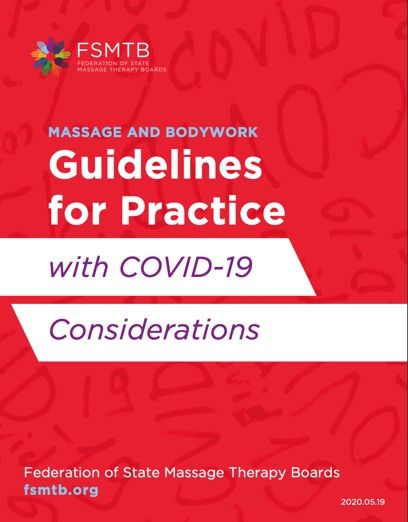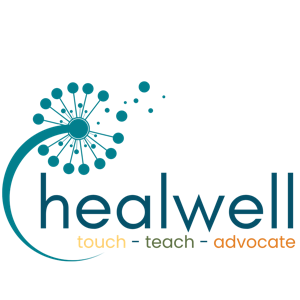The Federation of State Massage Therapy Boards convened a task force a few weeks ago to put their giant-sized brains together to outline some real guidelines for massage therapists practicing in a variety of settings for safe practice during COVID-19.
These things are the best we’ve seen so far.
They’re not perfect, but they cover some solid points and cover them well. Give them a read, even if you don’t plan to go back to work soon. Don’t be daunted by the length of the document. It’s formatted all fancy-like and it’s broken into sections for specific settings, so chances are good that you won’t find the entire document applies to your specific situation. Honestly, you can likely read “your” section or sections in 10 minutes or less.
Some themes that are repeated?
- masks (for you AND for your client); non-negotiable, folks (Some of your clients won’t love this, but we guarantee they’ll love it more than getting COVID.)
- declutter your waiting area and treatment space
- wash your hands… a lot
- make sanitizer easily available
- social distance in all aspects of the encounter where it’s possible
- disinfect! (this is not the same as “cleaning”)
- install no-touch items wherever you can (trash cans, payment, thermometer)
- proper ventilation is key (you can’t fudge this)
- post signage about cough and hand hygiene
These guidelines will give you some good resources, including intake forms, informed consent and scripts for pre-session client communication.

Other hits include…
Housecalls are not a thing that can safely happen “while COVID is present in a community.” And “safe face massage is not possible” when a client is wearing a mask, so faces will be off limits for now.
As much as we like these guidelines (and we offer a true and deep bow of gratitude to the task force members and to FSMTB) there are a few bits we want to point out that feel “open to interpretation” or are just plain missing.
First, we can’t resist mentioning that the document begins with this statement: “Clean facilities, proper practitioner hygiene, procedures to ensure client safety, and disease prevention protocols have long been a cornerstone of professional massage and bodywork practice.” If that were true, our profession wouldn’t be freaking out about COVID-19.
Early in the document, they suggest that “some customization and flexibility are necessary to allow these concepts to be of assistance in each jurisdiction and practice setting.” Do NOT read this as, “If any of these steps feel inconvenient or expensive, you can skip them.”
The guidelines state that “Each massage practice will have its own time frame for returning to work based on the state’s stay-at-home orders, supply of personal protective equipment (PPE), funding for massage programs, availability of COVID-19 tests, COVID-19 testing rates, and stable or falling COVID-related hospitalization rates for two weeks or more.” This is the closest the guidelines come to telling you what you should be looking at when you’re deciding if it’s reasonable to go back to massage practice. Don’t skip over it. Ask yourself if the region from which your clients predominantly come meets these criteria.
They also state, “Homemade cleaning products (e.g., vinegar and essential oils) are not approved cleaning agents or disinfectants.” Sorry, guys. Don’t meddle with the EPA-approved products. This virus is no joke. Follow the rules if you want to truly disinfect. Bleach and other cleaners will start to smell like the scent of safety. If you’re wondering what an EPA-approved cleaner is, you can check here. At the time of this blog, we are not aware of any cleaners approved by the EPA that can “kill COVID” quickly. Wet contact of no less than 5 (and often of 10 or more) minutes. If you have “a guy” who sells cleaning products who tells you he’s got an EPA product that kills COVID in “less than a minute,” you should look it up.
We LOVE that they make a clear point to discuss “cleaning” and “disinfecting” as very different activities. Some things need to be cleaned. More things need to be disinfected. Know the difference.
They recommend “HEPA air filtration systems when they are available.” They are available. Get them. Learn about ventilation and what it really means in terms of COVID-19. Swinging your office door open and closed a handful of times between clients doesn’t count. A small, oscillating fan doesn’t count either.
“While COVID-19 is present in a community, mobile massage/outcall massage is unsafe and therefore prohibited. Massage practitioners are unable to control the cleanliness or disinfection practices at client homes, exposing the massage practitioner to increased risk of infection.”
We like how this bit really isn’t left open for debate and they explain their rationale. The only problem is that we will all have to decide what it means for COVID-19 to be “present in a community.” Does that mean 10 cases? Does it mean 1,000 cases? In how large an area? Over what period of time? Be smart. Be safe. It means that, if you are going into a client’s home, you are placing a great deal of trust in that client with regard to disinfection practices and how they manage their social contacts. YOU will potentially be more at risk in these situations than your clients.
Anywhere you see the phrase “if available” or something similar, they’re telling you to do that thing. Find it. Make it available. It’s the safest way to handle whatever it is.
One thing that was just plain missing is any mention of cloth masks. They do a great job of exploring the different types of medical grade masks and their indications, but we know that many of us will be wearing homemade cloth masks, at least until PPE supplies get up to par. Listen. Homemade masks are better than nothing, but they’re not as good as surgical masks. If you are wearing cloth masks, they must be changed with EVERY client. No exceptions.
In closing, we want to highlight two of our favorite guidelines:
1. “Use a no-touch thermal temperature scan to confirm the client’s temperature is no higher than 100.4°F [38°C]. If a client has a temperature above 100.4°F, or if they have developed cold or flu-like symptoms or other symptoms suggesting illness since the pre-session phone call, reschedule their massage session and suggest that they call their primary care provider for consultation.”
FINALLY! Someone told us what to DO with the information we gather when we take a client’s temperature.
2. “If the client arrives wearing medical gloves, request that they remove these gloves before entry, as gloves may be contaminated with respiratory droplets from the client touching their nose or face.” We could kiss FSMTB on the face for that one. (Through a mask, of course.*) The trick will be to resist making people you see wearing gloves at the grocery store do the same thing.
Healwell is currently using these guidelines to create a Part II of our critically acclaimed online video course “Back to Practice Guidelines (In Practice).” Coming to a laptop near you… Back to Practice II: This Time It’s Personal (Protective Equipment).
(*NOTE: It is NOT actually safe to kiss the FSMTB… or anyone else… on the face through a mask.)
